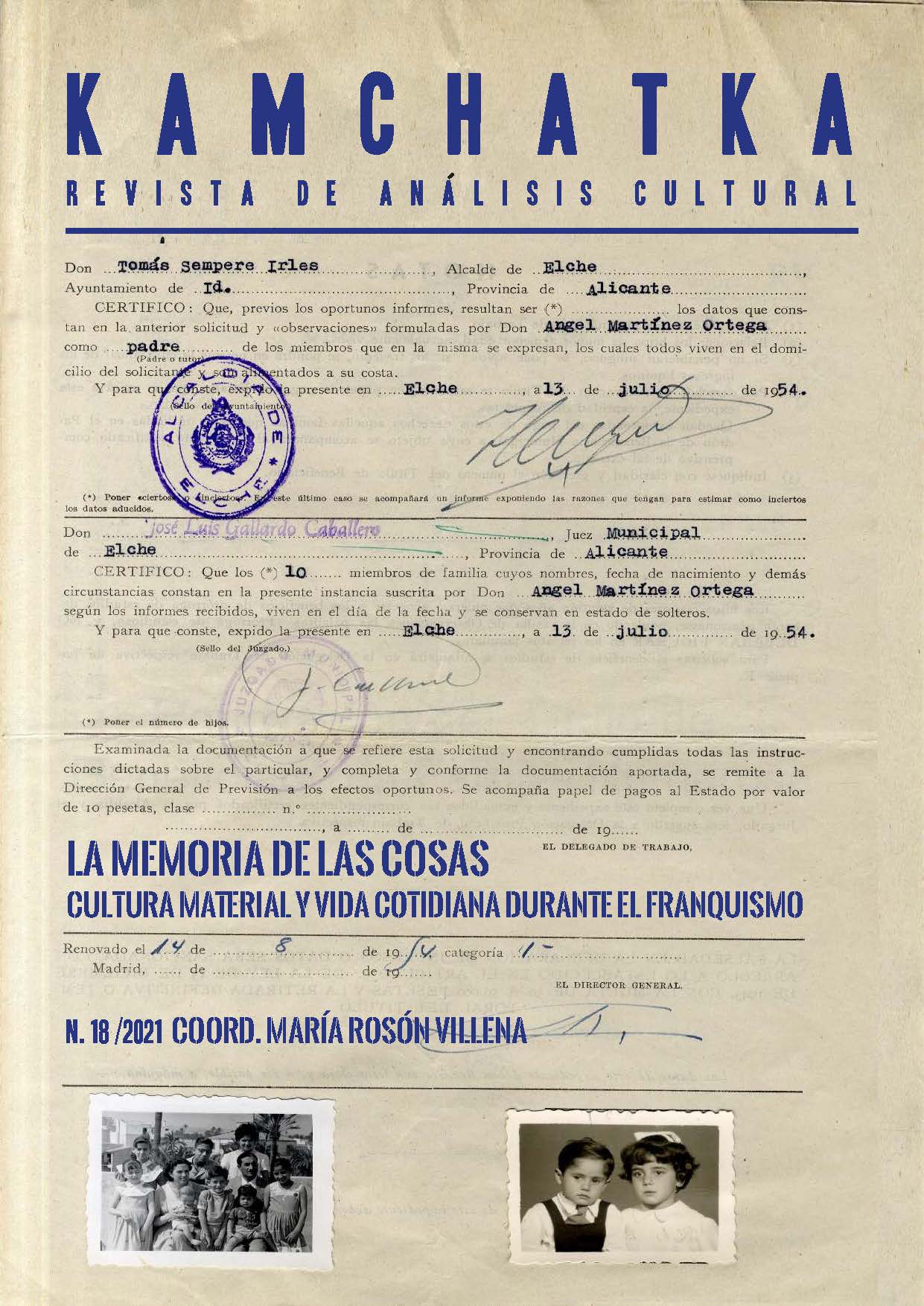The Becoming-Animal as Questioning of the Human in Pedro Juan Gutiérrez’s 'El Rey de la Habana' and Rafael Pinedo’s 'Plop'
DOI:
https://doi.org/10.7203/KAM.18.20729Keywords:
‘animal de adentro’, devenir-animal, Pedro Juan Gutiérrez, realismo sucio, Rafael Pinedo, literatura post-apocalíptica Abstract
Abstract
This paper intends to reveal different modes of how the concept of the human is questioned in two representative works of the contemporary Latin-American literature, in Pedro Juan Gutiérrez’s El Rey de la Habana, and Rafael Pinedo’s Plop. Although the baseline of this paper is literary, our approach to the novels will be interdisciplinary, considering that literary criticism will be combined with cultural analysis and aesthetics. We will handle a varied theoretical background including texts of Giorgio Agamben, Gilles Deleuze and Félix Guattari, Gabriel Giorgi, and Georges Bataille. After an introduction where we will present the distinction between ‘human’ and ‘non-human’, we will continue to investigate a series of ‘zones of indeterminacy’ (Giorgi 2012, 2014) where the ‘animal’ interferes with the ‘human’, among others, the eschatological (and the scatological), the corporal and the sexual. All that is to show how these two novels subvert, with a critical gesture, the boundaries of human culture. One of the most important intentions of this paper is to examine the function of, on the one hand, dehumanization and animalization of human body and subjectivity, and on the other, obscenity and vulgarity as countercultural discourses in the questioning of the human, that reveals itself even in the decay of the (literary) language.
 Downloads
Downloads
 References
References
Agamben, Giorgio (2006). Lo abierto. El hombre y el animal (trad. Costa, Flavia y Castro, Edgardo). Buenos Aires, Adriana Hidalgo Editora.
Agamben, Giorgio (2011). “Desnudez”. Desnudez (trad. Ruvituso, Mercedes y D’Meza, María Teresa). Buenos Aires: Adriana Hidalgo Editora: 79-133.
Basile, Teresa. “La escritura sucia de Pedro Juan Gutiérrez”. Katatay 6.8 (2010): 115-119.
Bataille, George (1997). El erotismo (trad. Vicens, Antoni, y Sarazin, Marie Paule). Barcelona, Tusquets.
Birkenmaier, Anke. “Más allá del realismo sucio: El Rey de la Habana de Pedro Juan Gutiérrez”. Cuban Studies 32 (2001): 37-54.
Catalin, Mariana. “Vidas más alá de la abyección. Los imaginarios para después del final de Rafael Pinedo”. HeLix 14 (2020): 130-149. (DOI https://doi.org/10.11588/helix.2020.2.77787)
Cruz-Grunerth, Gerardo (2014). “Deep Literature and Dirty Realism: Rupture and Continuity in the Canon”. Robbins, Timothy R. y González, José Eduardo (eds.). New Trends in Contemporary Latin American Narrative. Post-National Literatures and the Canon. New York: Palgrave MacMillan: 85-103.
Deleuze, Gilles y Guattari, Félix (2002). “Devenir-intenso, devenir-animal, devenir-imperceptible”. Mil mesetas. Trad. José Vázquez Pérez. Valencia: Pre-textos: 239-315.
Dobozy, Tamas. “In the Country of Contradictions the Hypocrite is King: Defining Dirty Realism in Charles Bukowski’s Factorum”. Modern Fiction Studies 62.1 (2001): 43-68. (DOI https://doi.org/10.1353/mfs.2001.0002)
Edwards, Matthew. “A la sombra del macho: Pedro Juan Gutiérrez y el desencuentro con la masculinidad en El Rey de la Habana”. Chasqui. Revista de Literatura Latinoamericana 36.2 (2007): 3-19.
Fornet, Jorge. “La narrativa cubana entre la utopía y el desencanto”. Hispamérica 32.95 (2003): 3-20.
Foucault, Michel (2007). Historia de la sexualidad. 1. La voluntad de saber (trad. Guiñazú, Ulises). México: Siglo xxi Editores.
Giorgi, Gabriel. “El ‘animal de adentro’: retóricas y políticas de lo viviente”. Voz y Escritura. Revista de Estudios Literarios 20 (2012): 181-194.
Giorgi, Gabriel (2014). Formas comunes. Animalidad, cultura, biopolítica. Buenos Aires: Eterna Cadencia.
Gutiérrez, Pedro Juan (1999). El Rey de la Habana. Barcelona: Anagrama.
Király, Jenő (1994). “Szexuálesztétika”. Frivol múzsa: a tömegfilm sajátos alkotásmódja és a tömegkultúra esztétikája. Budapest, Nemzeti Tankönyvkiadó: 787-931.
Koo, Pedro. “Tatuajes, perlanas y dietas: Transformando el cuerpo masculino en El Rey de la Habana de Pedro Juan Gutiérrez”. Hispanic Journal 29.1 (2008): 123-139.
Lemo, Matías. “El héroe en la literatura argentina contemporánea como sintetizador entre lo mítica y lo histórico: Plop, de Rafael Pinedo”. Gramma 31.8 (2020): http://portal.amelica.org/ameli/jatsRepo/260/2601431007/html/index.html. (DOI http://dx.doi.org/10.5209/alhi.66802)
Ludmer, Josefina (2004). “Ficciones cubanas de los últimos años: el problema de la literatura política”. Birkenmaier, Anke y González Echevarría, Roberto (coords.). Cuba: un siglo de literatura (1902-2002). Madrid: Editorial Colibrí: 357-371.
Matos Contreras, José Antonio. “Representaciones cotidianas del realismo sucio de Pedro Juan Gutiérrez: goce y agonía en La Habana”. Reflexiones Marginales. Revista de Filosofía 55 (2020): https://revista.reflexionesmarginales.com/representaciones-cotidianas-del-realismo-sucio-de-pedro-juan-gutierrez-goce-y-agonia-en-la-habana/.
Mercier, Claire. “Ecología humana en la trilogía de Rafael Pinedo: Plop, Frío y Subte”. Estudios de Teoría Literaria 5.10 (2016): 131-143.
Paz, Octavio (2002). Az erotikus túlpart: Sade (trad. Szőnyi, Ferenc). Budapest, Európa.
Pinedo, Rafael (2011). Plop. 2ª ed. Buenos Aires: Editorial Salto de Página.
Reati, Fernadno. “¿Qué hay después del fin del mundo? Plop y lo post post-apocalíptico en la narrativa argentina”. Rassegna Iberistica 98 (2013): 27-43.
Sontag, Susan (1969). “La imaginación pornográfica”. Estilos radicales (trad. Goligorsky, Eduardo). Edición digital (ePub): Titivillus, s/p.
Yelin, Julieta. “La voz de nadie. Sobre el pensamiento del cuerpo en la literatura latinoamericana reciente”. Pasavento. Revista de Estudios Hispánicos 7.1 (2019): 97-113.
Downloads
Published
How to Cite
-
Abstract1963
-
Artículo PDF (Español)787
Issue
Section
License
This journal provides an immediate free access to the content on the principle that freely make investigation available to the public, which promotes an increased global knowledge exchange.
Unless otherwise indicated, texts published in this journal are under the license Attribution-NonComercial 4.0 by Creative Commons. These texts may be copied, distributed and publicly communicated whenever the publication’s author and title are quoted and whenever they are not used for commercial purposes. In any case, intellectual property of the articles and its potential economic rights entirely belong to its authors.
The full license can be consulted on https://creativecommons.org/licenses/by-nc/4.0/. We encourage authors to disseminate papers published in Kamchatka. Journal of cultural analysis electronically, in institutional digital repository or in their websites.





